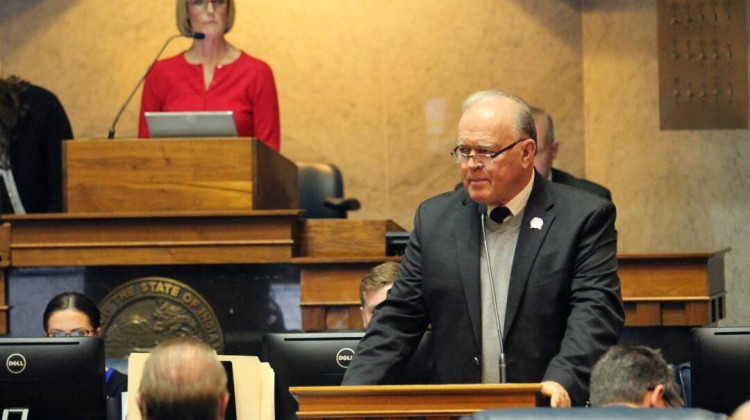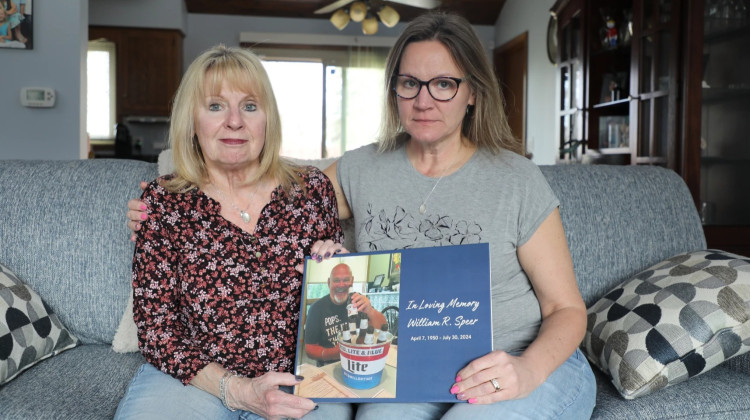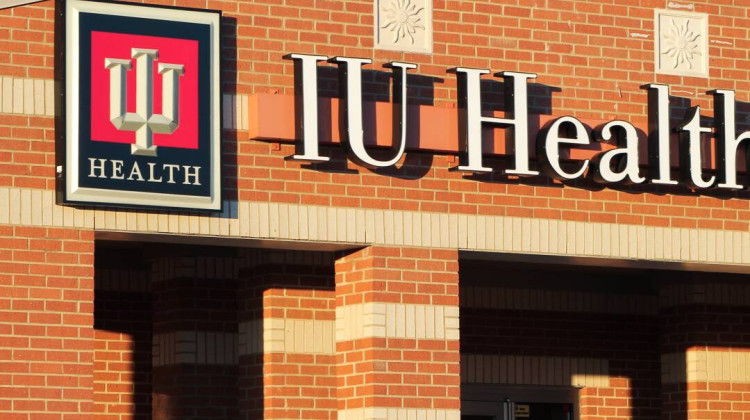
The Indiana Department of Health reported 71,595 new cases in the last week, adding more than 12,000 new cases three out of seven days.
(Lauren Chapman/IPB News)Indiana reports more than 15,000 new COVID-19 cases in a single day. State health officials open booster shots to Hoosiers 12 to 15 years old. And the Indiana House GOP’s bill to effectively ban private companies from enforcing vaccine mandates passes its first legislative hurdle.
THE DATA
The Indiana Department of Health reported 71,595 new cases in the last week, adding more than 12,000 new cases three out of seven days.
It also hit a new single-day record for new cases, reporting 15,277 new cases Thursday.
Indiana averaged 1,876.2 new cases per day in October, 2,707.3 in November, and 5,179.6 in December. In just the first week of January, the state has averaged 10,316.8 new cases per day.
The state added 573 new deaths to its total in the last week. And the state’s COVID-19 hospital census is currently at more than 3,300 Hoosiers.
HOSPITALIZATIONS
Skyrocketing omicron cases are less likely to be severe, but could still overwhelm hospitals
There is a lot of evidence to suggest that omicron cases are less likely to result in hospitalizations. But while the individual risk of severe infection is lower, experts say the skyrocketing number of COVID-19 cases may still result in a crush of new hospitalizations.
Micah Pollak is an associate professor of economics at Indiana University Northwest. He said characterizing omicron cases as “less severe” is true for individuals.
“But it’s so much more infectious and so much more contagious, and we’re operating in a situation where we have much less mitigations that any reduction in severity is going to just be swamped by how much more contagious it is,” Pollak said.
Join the conversation and sign up for the Indiana Two-Way. Text "Indiana" to 73224. Your comments and questions in response to our weekly text help us find the answers you need on COVID-19 and other statewide issues.
How? Pollak said it comes down to the math.
If the state sees about 2,000 new cases per day and about 15 percent are hospitalized, then you’re at about 300 new hospitalizations per day. That’s about what Indiana had with the delta variant.
“Now if you have omicron, that’s maybe hitting 20,000 cases per day – which is not unreasonable,” Pollak said. “Even if you have a 5 percent hospitalization rate, which is one-third the chance, you have 1,000 people being hospitalized a day.”
IU Health Arnett in Lafayette is at capacity with new COVID-19 cases with no real end to the surge in sight, according to health officials.
The hospital has expanded its number of ICU beds to 28, with well over 20 of those occupied for several weeks.
IU Health Arnett’s Dr. Chris Mansfield said the hospital has been transferring patients down to Indianapolis to relieve pressure on critical care staff who have already been stretched thin.
“However, today we have the highest volume in our totality in the IU Health system than any given day over the preceding many many months during this pandemic. So we’re running out of areas to send critical care patients to,” Mansfield said.
“It’s very difficult to functionally operate an emergency department out of just a slim number of ER beds,” he added.
Riley Children’s Hospital is treating record numbers of COVID-19 patients
Indiana’s hospitals continue to be overwhelmed with COVID-positive patients. That includes the state’s largest children’s hospital, Riley Hospital for Children in Indianapolis.
At a news conference on Tuesday, Riley Children’s Health chief medical officer Dr. Elaine Cox said about four times as many children are being admitted to Riley Hospital now than at any other point in the pandemic.
Cox said the children admitted to the hospital are also sicker.
“More than half the children admitted are spending time in the ICU, and at least 40 percent of those are spending time on the ventilator,” she said.
Of the 32 COVID patients at Riley Hospital, nine are pregnant women or new mothers in the maternity unit, 11 are in the pediatric intensive care unit and seven are on ventilators. The hospital’s overall capacity – including for non-COVID conditions – is at 87 percent, Cox said.
THE STATE HEALTH RESPONSE
Following CDC guidance, Indiana expands COVID-19 boosters to Hoosiers 12-15 years old
The Indiana Department of Health announced late Wednesday Hoosiers 12 to 15 years old are now eligible for booster shots. This comes after approval for the dose from the Centers for Disease Control and Prevention and the Food and Drug Administration.
Hoosiers 12 to 15 years old who received their Pfizer vaccine at least five months ago are eligible for the booster. Parents or guardians can register at OurShot.IN.gov or call 211.
READ MORE: Are COVID-19 vaccines safe for kids? Here's what you need to know
The Pfizer vaccine is the only one approved for individuals younger than 18, so when registering, make sure the site offers Pfizer.
IDOH announces new limitations for rapid COVID-19 tests at state sites
The Indiana Department of Health will limit rapid antigen COVID-19 testing at state sites to Hoosiers 18 and younger and symptomatic Hoosiers 50 and older. The state announced the change Tuesday as it deals with a nationwide shortage of rapid tests – but other testing is still available.
IDOH said in a press release the limitations are designed to help keep students in school and identify at-risk Hoosiers for antibody treatments within the prescribed window.
Indiana is only guaranteed 11,000 rapid tests per week, but uses about 50,000 at testing sites across the state.
THE STATEHOUSE
House, Senate leaders abandon all COVID-19 precautions for 2022 session
Indiana House and Senate leaders don’t appear to have many plans in place if there are significant COVID-19 outbreaks this session.
Last year, the House moved its entire chamber to a different government building, in order to spread out more. Many Senate committee hearings were changed to keep people testifying in separate rooms from lawmakers. Plexiglass dividers went up on both chamber floors.
This session – amid a worse surge of the virus than at any time in 2021 – none of those precautions are in place.
COVID-19 vaccine mandate ban legislation clears first hurdle, adds unemployment benefits
A bill to effectively ban private companies from enforcing COVID-19 vaccine mandates cleared its first hurdle at the Statehouse Thursday.
The measure – HB 1001, House Republicans’ top priority this session – passed a House committee.
The panel first made a few changes. The bill allows businesses to require weekly COVID-19 testing for employees who refuse to get the vaccine. And it says those businesses can’t charge their employees for the tests.
Lawmakers also added language to make unemployment benefits available for workers who are fired for applying for a vaccine exemption under the proposed rules and get fired instead. It's meant to act as a punishment for employers who don't comply by raising their contributions to the state's unemployment insurance trust fund.
The Department of Workforce Development said, currently, workers can’t claim unemployment benefits if the employer has a "reasonable" vaccination policy.
House GOP’s 2022 priorities include tax cuts, curbing COVID-19 vaccine mandates
Indiana House Republicans’ 2022 agenda is led by efforts to cut $1 billion in taxes and curb COVID-19 vaccine mandates.
Those are also items that don’t have ringing endorsements from either Senate Republicans or the governor.
The House GOP’s tax reform package is a mix of business, utility and individual tax cuts, eventually costing the state more than $1 billion a year. Senate Republicans and the governor have balked at such a price tag this session, expressing concern for revenue stability and future spending needs.
THE HEADLINES
State Health Commissioner Dr. Kris Box reinfected with COVID-19, isolating at home
State Health Commissioner Dr. Kris Box has become reinfected with COVID-19. She tested positive after developing symptoms last Monday, and has been isolating at home.
Box also tested positive for COVID-19 in October 2020 after two workers at her grandson’s day care got sick. Her daughter and grandson had mild symptoms, but she was asymptomatic.
She is fully vaccinated and received her booster shot in November.
The Indiana Department of Health said in a news release Box’s PCR test will be sequenced to determine if she has been infected with the omicron variant.
Purdue University outlines plans for in-person start to next semester
Purdue University Tuesday outlined its plans for an in-person start to the second semester, as the school reported its sharpest increase in COVID-19 testing positivity rates this academic year.
The school’s COVID dashboard, updated for the first time since mid-December, showed a seven-day testing positivity rate of 16.43 percent. The overall testing positivity rate from Aug. 1 to Dec. 31 was 1.73 percent.
A statement on the dashboard webpage said the university had focused its recent testing on symptomatic individuals and close contacts of those exposed to COVID, and that “because of this, positivity rates are influenced and expected to be elevated for several more weeks.”
“In the fall, we had hoped and expected to reduce some safety requirements early this semester, but the emergence of the omicron variant has forced us to delay any such easing, at least for a while,” Purdue said in a statement sent to the school community Tuesday.
Ball State University begins spring semester Monday with in-person instruction
Students are returning to the Ball State campus for the start of spring semester on Monday, Jan. 10.
University administrators decided to start classes with in-person instruction — with faculty ready to pivot to online teaching should the COVID-19 pandemic surge to more dangerous levels than we see today.
Database: Indiana schools' plans for $3 billion in federal COVID-19 stimulus
The pandemic upended education for about 50 million American students, and U.S. lawmakers responded by giving schools an unprecedented surge of federal funding — including nearly $3 billion for Indiana schools.
The aid has few restrictions, so districts can decide what they need to operate during the enduring crisis and what will help make up for the instruction students have missed out on. School systems with larger shares of children from low-income families received more money.
Although public information on how districts use the aid is inconsistent and often hard to find, schools were required to post plans on their public websites of how district leaders will use the latest round of funding. District leaders decide what to include in the plans, however, and some are far more detailed than others.
The three rounds of stimulus, which were progressively larger, include the CARES Act, a second stimulus bill under President Donald Trump, and the American Rescue Plan under President Joe Biden. All of the aid is known as Elementary and Secondary School Emergency Relief or ESSER, a name commonly used on school district websites and school board presentations. The aid must be spent by late 2024.
Insurance executive says death rates among working-age people up 40 percent
As COVID-19 deaths approach 19,000 in Indiana, the insurance industry has been processing claims at a record rate.
Nationally, more than 824,000 people have died from the virus.
“We’re seeing right now the highest death rates we’ve ever seen in the history of this business,” said Scott Davison, the CEO of OneAmerica, a $100 billion life insurance and retirement company headquartered in Indianapolis. “The data is consistent across every player in the business.”
Davison said death rates among working age people – those 18 to 64-years-old – are up 40 percent in the third and fourth quarter of 2021 over pre-pandemic levels.
“Just to give you an idea of how bad that is, a three sigma or 200-year catastrophe would be a 10 percent increase over pre-pandemic levels,” Davison said. “So, 40 percent is just unheard of.”
Before Aug. 1, 2021, Hoosiers 50 and younger accounted for about 2 percent of the state’s total COVID-19 deaths. Since then, they account for nearly 10 percent.
Contact Lauren at lchapman@wfyi.org or follow her on Twitter at @laurenechapman_.
 DONATE
DONATE






 Support WFYI. We can't do it without you.
Support WFYI. We can't do it without you.